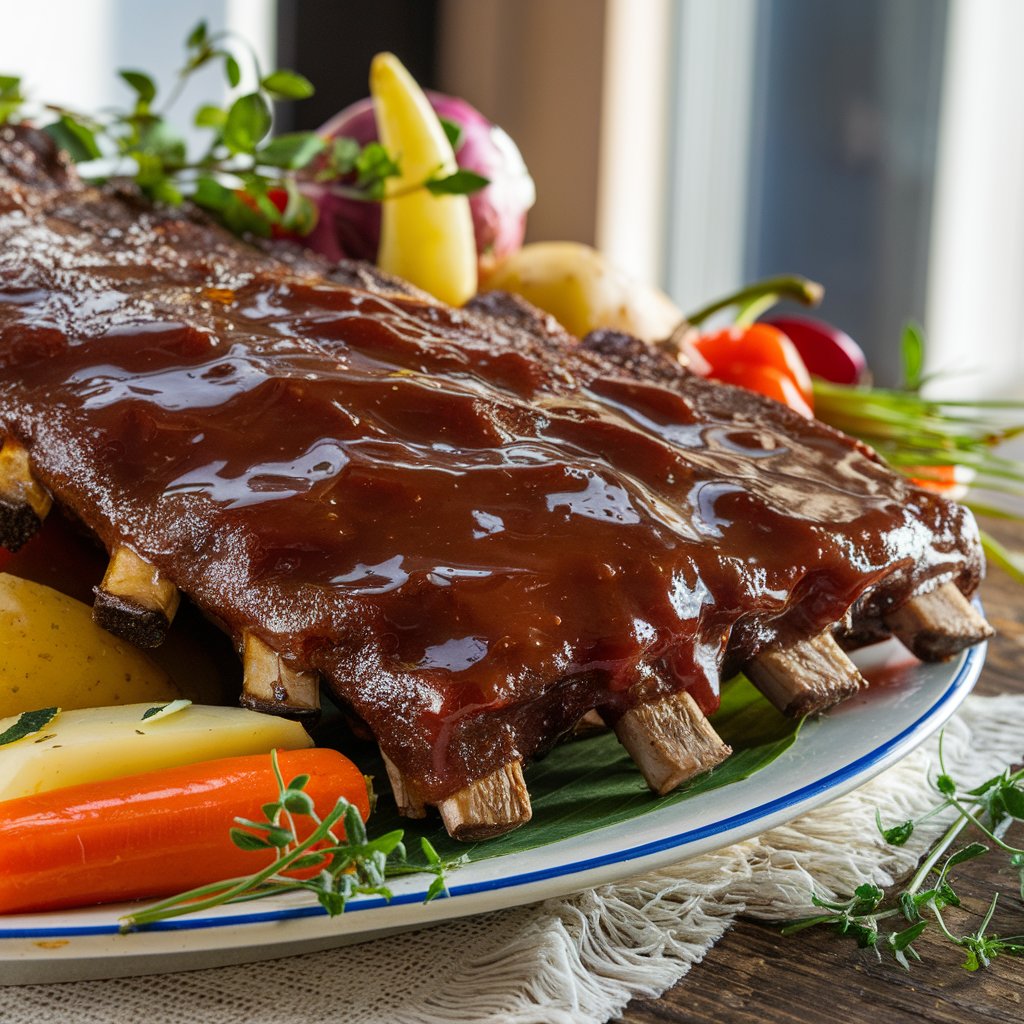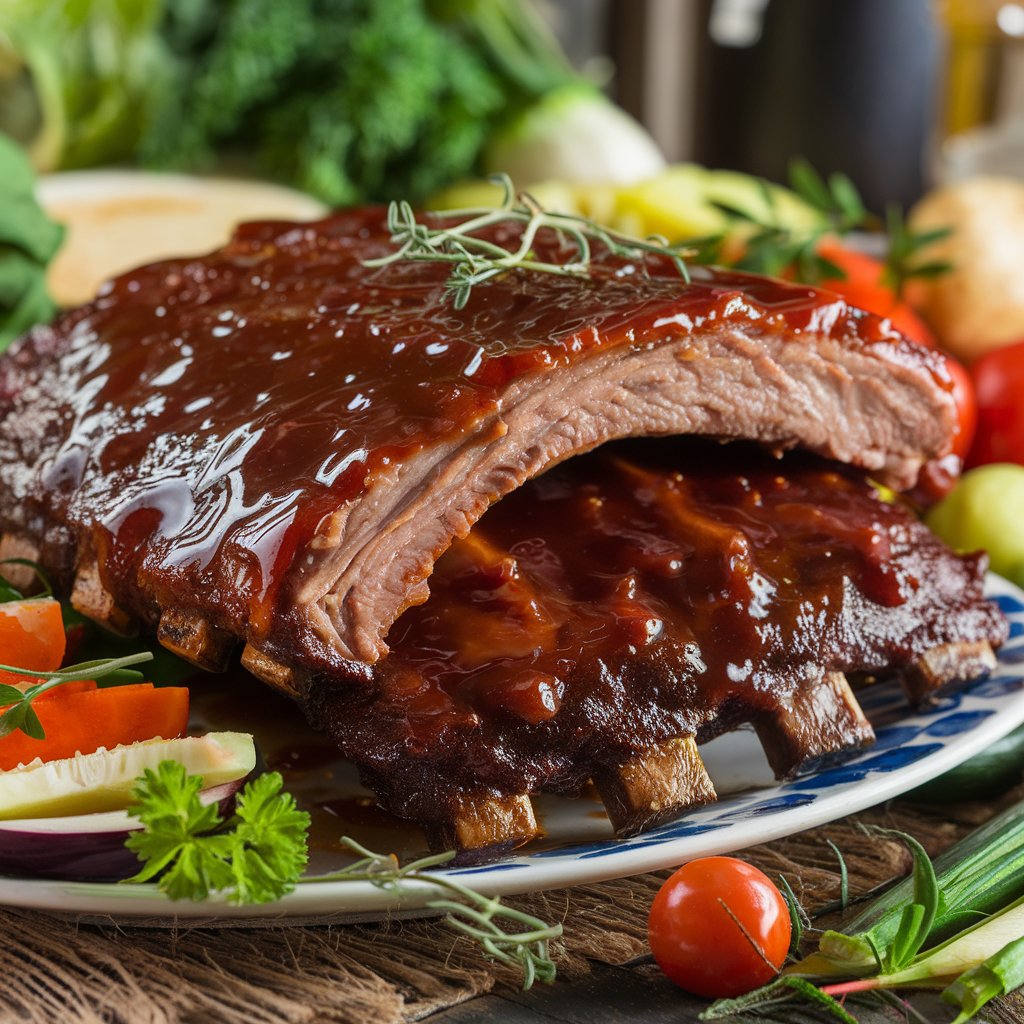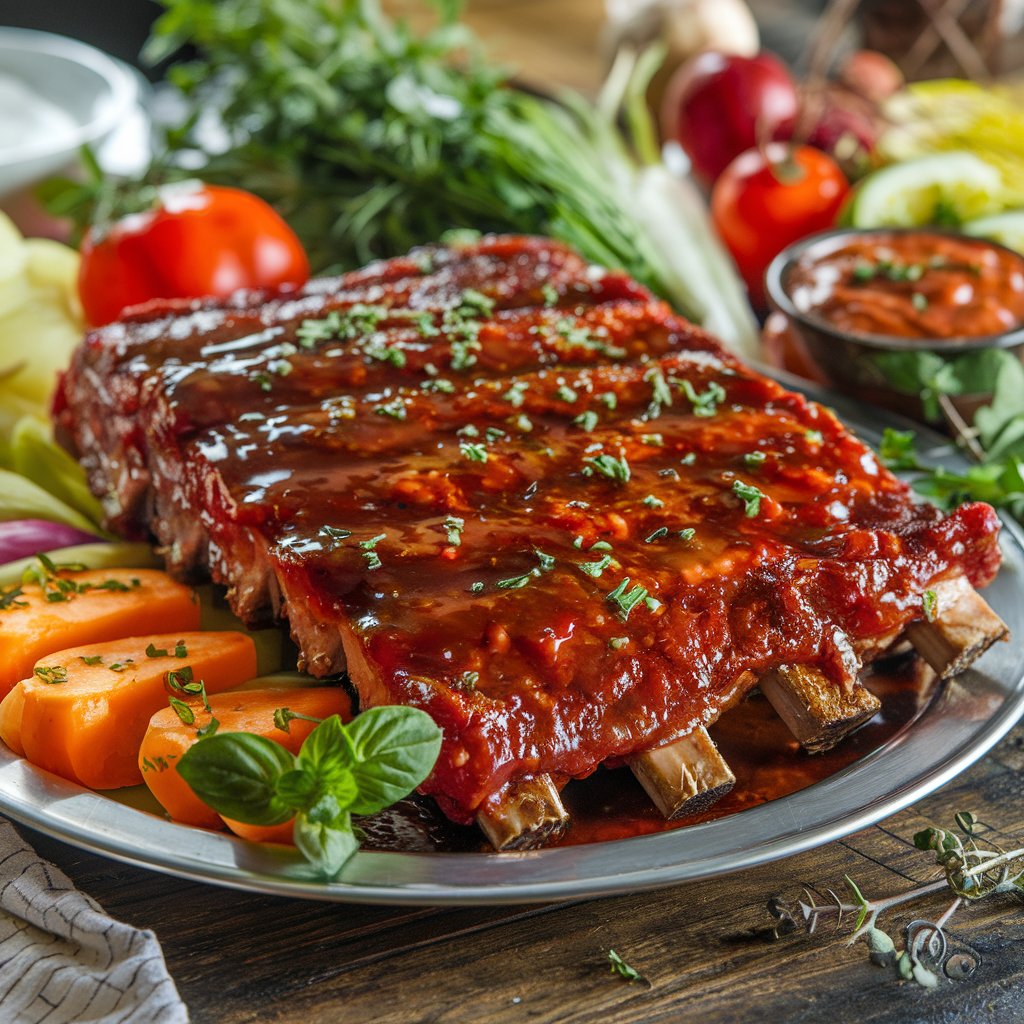Table of contents
Introduction
If you’re craving a hearty, flavorful meal, this beef back ribs is just what you need. Cooking beef ribs low and slow in the oven ensures they are fall-off-the-bone tender and infused with rich, smoky flavors. Whether for a family dinner or a special gathering, this dish is sure to impress.
Beef back ribs are a true delight for meat lovers. These ribs, known for their rich, beefy flavor and tender texture, are a staple at barbecues, family dinners, and special gatherings. Whether you’re a pitmaster or a novice in the kitchen, mastering beef back ribs can elevate your cooking game.
In this article, we’ll explore everything you need to know about beef back ribs: their cuts, cooking methods, common mistakes, and delectable recipes. If you’ve ever wondered how to achieve the perfect balance of tenderness and flavor, you’re in the right place!
What Are Beef Back Ribs?
Beef back ribs come from the upper section of the cow’s rib cage, near the backbone. They’re what’s left when the ribeye steak is removed from the bone. This cut is characterized by long bones with small portions of meat clinging between them. While they might not look meaty at first glance, their flavor is unmatched, thanks to the marbling and fat content that infuse every bite with juiciness.
Why Are Beef Back Ribs So Popular?
What makes beef back ribs so special? It’s their versatility. You can grill, smoke, bake, or braise them, tailoring the cooking method to your taste. They’re also relatively affordable compared to other cuts like ribeye or brisket, making them accessible for home cooks.
Another reason for their popularity is their role as the star of backyard barbecues. Picture a sizzling rack of ribs on the grill, the aroma filling the air as the meat caramelizes to perfection. It’s a crowd-pleaser every time!
“Beef back ribs have a way of bringing people together, whether it’s a summer cookout or a cozy family dinner.” 🥩✨
Nutritional Value of Beef Back Ribs
Beef back ribs are not just tasty—they also pack a nutritional punch. A typical serving provides:
- Protein: Essential for muscle repair and growth.
- Iron: Supports oxygen transport in the body.
- B Vitamins: Vital for energy production.
- Healthy Fats: Offer a source of sustained energy and satiety.
However, moderation is key. Like many indulgent dishes, beef back ribs can be calorie-dense, especially when paired with sauces and sides. Balance them with lighter accompaniments for a well-rounded meal.
Different Cuts of Beef Back Ribs
Understanding the different cuts of beef back ribs can help you select the best option for your recipe. Let’s break it down!
Back Ribs vs. Short Ribs: What’s the Difference?
People often confuse beef back ribs with short ribs, but they’re distinct in both texture and flavor.
- Beef Back Ribs: These are longer and leaner, taken from the upper rib cage. They’re great for grilling and smoking because they cook relatively quickly.
- Short Ribs: Found lower on the cow, short ribs are meatier and more marbled. They’re ideal for slow-cooking methods like braising, as they become tender over time.
How to Choose the Best Beef Back Ribs
When shopping for beef back ribs, keep these tips in mind:
- Look for Marbling: Small streaks of fat in the meat indicate flavor and tenderness.
- Avoid Excessive Bone Exposure: Ribs with too much bone and not enough meat may disappoint.
- Check Freshness: Fresh beef should have a deep red color and no off-putting odor.
Where to Buy Quality Beef Back Ribs
You can find beef back ribs at most butcher shops and supermarkets, but the quality can vary. Here’s where to look:
- Local Butchers: Often provide fresher, higher-quality cuts.
- Online Meat Suppliers: Convenient for sourcing premium ribs, often shipped frozen.
- Supermarkets: Look for ribs in vacuum-sealed packaging for freshness.
Preparing Beef Back Ribs for Cooking
To achieve mouthwatering beef back ribs, proper preparation is crucial. Skipping this step can lead to uneven cooking or tough meat.
Essential Tools for Cooking Beef Back Ribs
Before you begin, make sure you have the right tools. These include:
- Sharp Knife: For trimming excess fat and cleaning the ribs.
- Meat Thermometer: Ensures you cook the ribs to the perfect internal temperature.
- Grill or Smoker: Essential for achieving that authentic barbecue flavor.
- Basting Brush: For applying sauces and marinades evenly.
How to Clean and Trim Beef Back Ribs
Cleaning beef back ribs ensures they’re free from impurities and ready for seasoning. Follow these steps:
- Rinse and Pat Dry: Wash the ribs under cold water and pat them dry with paper towels.
- Remove the Membrane: The silverskin membrane on the bone side can prevent seasonings from penetrating the meat. Use a knife to lift one corner, then peel it off.
- Trim Excess Fat: While some fat is good for flavor, trimming excess ensures your ribs aren’t overly greasy.
Popular Seasonings and Marinades
The secret to great beef back lies in the seasoning. Here are some classic options:
- Dry Rubs: A blend of salt, pepper, paprika, garlic powder, and brown sugar adds depth and caramelization.
- Marinades: Soy sauce, vinegar, and Worcestershire sauce create a tangy, tenderizing marinade.
- Herbs and Spices: Experiment with rosemary, thyme, and chili powder for a unique twist.
“Seasoning is like the love language of cooking—it’s where your ribs start to develop their personality!” 🌟
Best Cooking Methods for Beef Back Ribs
Cooking beef back ribs is as much an art as it is a science. While they’re naturally flavorful, the method you choose can significantly enhance their taste and texture. From grilling to smoking and oven-baking, there’s a cooking style to suit every preference. Let’s explore the best ways to prepare these mouthwatering ribs!
Grilling Beef Back Ribs
Grilling is a popular way to cook beef back ribs, especially during the summer. The open flames and smoky aroma give the ribs a charred, caramelized crust that pairs beautifully with their tender interior.
Step-by-Step Grilling Instructions
- Preheat the Grill: Set up your grill for indirect heat. If using charcoal, push the coals to one side. For gas grills, light one burner and leave the others off.
- Season the Ribs: Apply your favorite dry rub or marinade, ensuring the ribs are evenly coated.
- Place the Ribs on the Grill: Lay them bone-side down on the cooler side of the grill to avoid direct heat.
- Cook Low and Slow: Cover the grill and maintain a temperature of 250–275°F. This slow cooking ensures tender ribs.
- Baste Occasionally: Brush the ribs with BBQ sauce or melted butter every 30 minutes for extra flavor and moisture.
- Check for Doneness: Use a meat thermometer to check the internal temperature, aiming for 190°F for fall-off-the-bone ribs.
- Sear (Optional): For extra char, sear the ribs over direct heat for 2–3 minutes per side.
Pro Tip: Always let your ribs rest for 10 minutes before slicing. This helps retain their juices.
🔥 “Grilling beef back ribs is like painting on a canvas—the flames are your brush, and the ribs are your masterpiece.”
Smoking Beef Back Ribs
Smoking beef back ribs is the ultimate choice for barbecue purists. The long, slow process infuses the meat with a rich, smoky flavor that’s impossible to resist.
How to Achieve the Perfect Smoke Flavor
- Choose Your Wood: Hickory and mesquite provide bold flavors, while fruit woods like apple and cherry offer a sweeter profile.
- Prep the Smoker: Preheat your smoker to 225°F and add your wood chips or chunks.
- Season the Ribs: Apply a dry rub, ensuring every crevice is covered.
- Smoke the Ribs: Place the ribs on the smoker grate, bone-side down. Close the lid and smoke for 4–6 hours, depending on the size of the ribs.
- Spritz for Moisture: Every hour, spritz the ribs with apple juice, vinegar, or water to keep them moist.
- Wrap in Foil (Optional): After 3 hours, wrap the ribs in aluminum foil to lock in moisture and speed up cooking.
- Finish with Sauce: During the final 30 minutes, unwrap the ribs and brush them with your favorite BBQ sauce.
“Smoking ribs requires patience, but the result is worth every second—a smoky, tender masterpiece that melts in your mouth.”
Oven-Baked Beef Back Ribs
If you don’t have a grill or smoker, don’t worry! Oven-baking is a simple and reliable method to achieve tender,
Simple Techniques for Tender Ribs
- Preheat the Oven: Set your oven to 300°F.
- Season Generously: Rub the ribs with a mixture of salt, pepper, garlic powder, and paprika.
- Wrap in Foil: Place the ribs on a baking sheet and wrap them tightly in aluminum foil to retain moisture.
- Bake Low and Slow: Bake for 2.5–3 hours, checking occasionally to ensure they don’t dry out.
- Add Sauce: During the last 30 minutes, remove the foil and brush the ribs with BBQ sauce. Increase the temperature to 400°F to caramelize the sauce.
- Rest and Serve: Let the ribs rest for 10 minutes before slicing to allow the juices to redistribute.
Oven-baking is perfect for those rainy days when outdoor grilling isn’t an option. It’s also a foolproof method for beginners!
Common Problems When Cooking Beef Back Ribs
No matter how experienced you are, can come with its fair share of challenges. Here are some common issues and how to fix them.
Why Are My Ribs Dry?
Dry ribs are a common problem, often caused by cooking at too high a temperature or skipping the basting process.
Solution: Always cook your ribs low and slow, maintaining a temperature between 225–275°F. Baste the ribs regularly to keep them moist, and consider wrapping them in foil during the cooking process.
How to Avoid Tough Ribs
Tough ribs result from undercooking. Remember, beef back ribs need time to break down the connective tissues.
Solution: Use a meat thermometer to ensure the ribs reach an internal temperature of 190°F. Patience is key—rushing the cooking process won’t yield tender results.
Fixing Over-Seasoned or Overcooked Ribs
Too much seasoning or overcooking can overpower the natural flavor of beef back
Solution: If the ribs are over-seasoned, balance the flavors with a mild sauce or glaze. For overcooked ribs, try simmering them in a sauce or broth to restore some moisture.
Recipes, Side Dishes, and Storing Beef Back Ribs

Delicious Beef Back Ribs Recipes
Cooking beef back ribs is an adventure, and trying new recipes keeps the experience exciting. Whether you prefer classic BBQ flavors or want to explore global cuisines, these recipes are guaranteed to impress.
Classic BBQ Beef Back Ribs
The quintessential barbecue experience revolves around perfectly cooked BBQ beef back ribs. Here’s a foolproof recipe:
Ingredients:
- 3 tbsp of BBQ dry rub (store-bought or homemade)
- 1 cup of BBQ sauce
- 1/4 cup of apple cider vinegar
Instructions:
- Preheat your grill to 250°F for indirect heat.
- Remove the membrane from the ribs and pat them dry.
- Rub the ribs with the dry rub, ensuring even coverage.
- Place the ribs bone-side down on the grill.
- Cook for 2–3 hours, spritzing occasionally with apple cider vinegar.
- During the last 30 minutes, brush the ribs generously with BBQ sauce.
- Let the ribs rest for 10 minutes before serving.
🔥 Tip: For extra smoky flavor, add wood chips to your grill.
Asian-Inspired Beef Back Ribs
If you’re looking for a twist, these Asian-style ribs bring bold, umami-packed flavors to the table.
Ingredients:
- 1/2 cup soy sauce
- 1/4 cup honey
- 2 tbsp sesame oil
- 1 tbsp minced garlic
- 1 tbsp grated ginger
- 1 tsp chili flakes
Instructions:
- Combine soy sauce, honey, sesame oil, garlic, ginger, and chili flakes in a bowl. Reserve 1/4 cup for basting.
- Marinate the ribs in the mixture for 4–6 hours (or overnight).
- Bake the ribs in a 300°F oven for 2 hours, wrapped in foil.
- Brush with the reserved marinade and broil for 5–7 minutes for a sticky glaze.
Spicy Cajun Beef Back Ribs
For those who like a little heat, this Cajun-inspired recipe delivers a fiery punch.
Ingredie
- 2 tbsp Cajun seasoning
- 1 tbsp smoked paprika
- 1 tsp cayenne pepper
- 1/4 cup butter (melted)
- 1/2 cup hot sauce
Instructions:
- Preheat your smoker or oven to 225°F.
- Rub the ribs with Cajun seasoning, paprika, and cayenne pepper.
- Smoke or bake for 3–4 hours, spritzing occasionally with water.
- Combine melted butter and hot sauce, then brush onto the ribs during the final hour.
- Serve with extra hot sauce on the side.
“Experimenting with different flavors is the best way to discover your favorite rib recipe!” 🌟

Pairing Beef Back Ribs with Side Dishes
The right side dishes can elevate your beef back ribs to a complete culinary experience. From creamy potatoes to fresh salads, here are the best pairings.
Best Side Dishes for Beef Back Ribs
- Mashed Potatoes: Creamy, buttery mashed potatoes balance the richness of the ribs.
- Coleslaw: A crunchy, tangy coleslaw adds freshness to the meal.
- Grilled Corn on the Cob: Sweet, smoky corn pairs wonderfully with the deep flavors of BBQ ribs.
- Baked Beans: Slow-cooked baked beans offer a hearty complement.
- Macaroni and Cheese: A creamy, cheesy side dish that’s always a crowd-pleaser.
Perfect Drinks to Complement Beef Back Ribs
- Beer: A crisp lager or hoppy IPA cuts through the richness of the ribs.
- Red Wine: Bold reds like Zinfandel or Malbec enhance the beefy flavor.
- Lemonade: A refreshing, non-alcoholic option that balances the smoky flavors.
Storing and Reheating Beef Back Ribs
If you have leftovers (lucky you!), proper storage and reheating are essential to preserve the ribs’ flavor and texture.
Best Practices for Storing Leftovers
- Cool Down Quickly: Let the ribs cool to room temperature before storing.
- Wrap Securely: Use aluminum foil or airtight containers to prevent moisture loss.
- Refrigerate or Freeze:
- Refrigerate for up to 3 days.
- Freeze for up to 3 months.
Reheating Beef Back Ribs Without Losing Flavor
Reheating ribs can be tricky—you want them hot but not dry. Here are some methods:
- Oven:
- Preheat to 300°F.
- Wrap the ribs in foil and add a splash of water or broth.
- Heat for 20–30 minutes.
- Microwave:
- Place ribs on a microwave-safe plate.
- Cover with a damp paper towel.
- Heat in 1-minute intervals until warm.
- Grill:
- Heat the grill to medium.
- Place ribs directly on the grill for 5–10 minutes, flipping occasionally.
Conclusion
Beef back ribs are a culinary treasure that can transform any meal into a feast. From understanding their cuts and cooking techniques to experimenting with global flavors and mastering side pairings, there’s always something new to learn and enjoy. Whether you’re grilling on a sunny afternoon or baking in the comfort of your kitchen, beef back ribs promise satisfaction with every bite.
So, grab a rack of ribs, fire up the grill (or oven), and dive into this delicious journey. Your taste buds will thank you!

